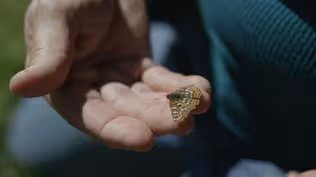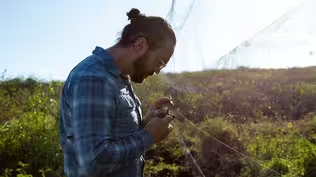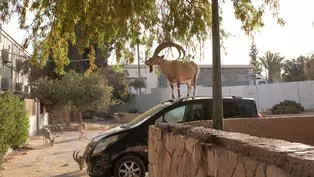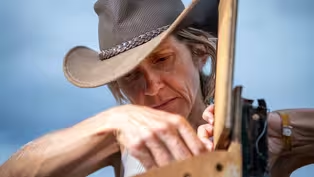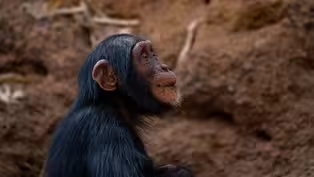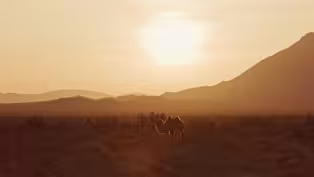
Heat
Episode 3 | 55m 31sVideo has Closed Captions
In the hottest places, species are going to extraordinary lengths to survive.
Travel to the hottest and driest extremes to see animals go to extraordinary lengths to survive. From the Sahara Desert to Australia, animals provide new clues about our changing planet and what it will mean for the future of our heating world.
Problems playing video? | Closed Captioning Feedback
Problems playing video? | Closed Captioning Feedback

Heat
Episode 3 | 55m 31sVideo has Closed Captions
Travel to the hottest and driest extremes to see animals go to extraordinary lengths to survive. From the Sahara Desert to Australia, animals provide new clues about our changing planet and what it will mean for the future of our heating world.
Problems playing video? | Closed Captioning Feedback
How to Watch Evolution Earth
Evolution Earth is available to stream on pbs.org and the free PBS App, available on iPhone, Apple TV, Android TV, Android smartphones, Amazon Fire TV, Amazon Fire Tablet, Roku, Samsung Smart TV, and Vizio.
Buy Now

Evolution Earth
Traveling to the far corners of the world, we discover the extraordinary ways animals are adapting to our rapidly changing planet. We witness nature’s remarkable resilience, as our perception of evolution and its potential is forever transformed. Read these interviews with experts to learn more.Providing Support for PBS.org
Learn Moreabout PBS online sponsorship[narrator] In the hottest places on Earth, the natural world is pushed to do extraordinary things.
As our planet heats up, even the smallest degrees of change can make a staggering difference.
Animals are showing a resilience that's hard to dream of... until you see it with your own eyes.
♪ [Chimps barking] ♪ Even our closest relatives, living in the hottest part of their world, are doing something that's never been filmed before.
[Chimp grunting] ♪ My name's Shane Campbell-Staton.
I'm an evolutionary biologist.
I'm here to tell you stories from filmmakers, scientists, and local experts across the globe about a pulse of change.
♪ The entire planet is shifting.
The climate is changing at an incredible 170 times faster than it should be.
♪ We can't always see it.
We're so caught up in our own thing, you know?
But the signs are everywhere.
♪ The entire tree of life is whispering to us.
[Water splashing] We just have to pay attention.
[Snorting] Out there, things aren't what you expect.
You'll see.
♪ These chimps are pioneering apes.
They live at the hottest extreme of any chimpanzee's range.
♪ And their home is getting hotter.
♪ We spent weeks on the savanna with them.
And of all the animals we filmed in this series, it was spending time with the chimps that really stood out.
♪ We fell in love with these guys, just like primatologist Jill Pruetz did 22 years ago.
♪ Despite the intense heat, she still never tires of hanging out with her Fongoli chimps.
[Jill] I still feel really happy, like, giddy when I see them.
There's always something new going on.
Yeah, I still get a buzz.
♪ What stands out when you're with the chimps is they have, you know, biological adaptations to dealing with heat.
[Campbell-Staton] These chimps are a bit different from their forest cousins.
They look less hairy and they walk upright more than chimps elsewhere in Africa.
The more you look, the more it feels like you're watching a chapter of our own evolutionary history.
[Jill] When I imagine early humans, this is kind of what I see.
The habitat had a large influence on our own evolution.
The same types of pressures must have been impacting them.
♪ This type of environment is very similar to what our first bipedal ancestors lived in.
♪ [Campbell-Staton] After filming with the chimps for the first episode of the series, Jill told us there was more to this story.
A new behavior never filmed before.
They're just here.
[Campbell-Staton] And we should stay and see if we could film it with remote cameras.
It's behavior other chimps don't do... and it only happens here, when it gets hot.
I mean really hot.
When it gets to be, like, 107, 110, it doesn't matter whether it's a wet heat or a dry heat: it's just hot.
♪ As the mercury rises in the dry season, it feels like the chimps are at a breaking point.
♪ The heat stress falls hardest on momma and her baby.
♪ [Jill] Females that have young infants that are nursing, they're going to be stressed.
You know, you want out of the sun.
♪ [Campbell-Staton] The pressure of the extreme heat pushes these chimps to do something extraordinary.
♪ Other chimps will not do this.
♪ Caves like this, that's where predators hide out.
♪ They could get cornered in here.
They must rewire years of instinctual fear to become... "indoor chimps."
♪ And our remote cameras were there to capture it.
[Chimps grunting] Momma and baby finally get some respite from the midday sun.
She heads even deeper into the cave, crawling into a chamber beyond the overhang.
[Jill] Females that are nursing and really stressed by heat will be hanging around the cave.
The caves are consistently cooler.
[Campbell-Staton] And when she says cooler, she means an astonishing 23 degrees cooler than outside.
[Chimp barking] And everyone wants a piece of this action.
[Jill] If there are a lot of chimps around, the adult males will actually compete over access to the caves.
[Campbell-Staton] It's still early days to start describing this cave behavior... but this is what I would categorize as "chillaxing."
♪ When the afternoon cools off, it's time to head back to the plains.
♪ These chimps are on the front line of our warming planet.
They are experiencing an environment changing 10 times faster than our ancestors did 5 million or 6 million years ago.
What's more, the changes now are happening faster than any other time in the past 65 million years.
♪ Jill's working out what all this means for the future of her Fongoli chimps.
[Jill] It seems like the chimps could exist up until the year 2080.
[Campbell-Staton] After that, the rise in temperature means there likely won't be enough water.
[Jill] At that point, the chimps couldn't survive.
[Campbell-Staton] Not even the caves would help.
And who knows where they would move to then?
As our planet warms, every creature--including us-- will need to find new ways to cope.
[Chimps grunting] When I got intel from the Negev Desert about a group of animals finding new ways to survive their home being baked to a crisp... well, I knew we had to go and see it.
[Birds chirping] Here in the desert, rising temperatures mean droughts last longer, heat waves are more intense, water sources are drying out, and valleys are turning to dust.
[Bird squawking] [Fly buzzing] The next generation of these Nubian ibex must learn a new way of making a living here.
♪ It starts with a big climb for a little goat.
♪ Usually, a mother would take her kid into the valley to find something to eat.
But in the last 30 years, some of the Negev has lost 2/3 of its vegetation.
And temperatures have risen by 3 degrees.
So, the residents of this desert... have no choice but to become migrants.
These ibex are heading up... and out.
[Bird squawking] When the chips are down, sometimes you just got to head to the city.
[Dog barking] Settlements like this one are made possible with technology that allows over a million people to now call the desert their new home.
An opportunity to be exploited... if you dare.
Ibex were hunted to near extinction just a few decades ago.
So, when you think about it, this mom must overcome a fear of humans handed down over generations.
They're nervous, but times are desperate.
And she leads her kid on into a strange oasis.
♪ They stay long enough to get their fill... and quickly return to the sanctuary of the desert.
Now, there's a twist to this story.
The picture changes as you move from one desert town to another.
♪ In the older, larger settlements-- where there's more people-- the ibex are becoming more accustomed to our human world.
♪ Here, the ibex are no longer sneaking around.
♪ They're owning this place.
♪ [Horn honking] ♪ They've changed their behavior so radically... they've pretty much moved in.
♪ [Dog barking] ♪ They seem to have lost their innate fear, and they're happy to adopt all the trappings of city life.
♪ They're now as much at home here as the locals.
♪ Everything is fair game.
♪ [Car alarm sounding] ♪ [Laughing] So, remind me not to park here.
♪ Researchers are finding that ibex here are becoming bolder than the ibex in the first settlement we visited.
♪ And the more they stay in town, the more they become isolated populations, changing--even at the genetic level.
We know that animals all over the world are adapting to life in the city.
So, who knows where this'll take them?
"Extreme hot zones" are described as places so hot, they're nearly unlivable.
And scientists predict these areas are going to rise from 1% of the Earth's surface to a staggering 19% by 2070.
♪ If this is going to be the surface of nearly 1/5 of our planet, we need to get to know the place.
♪ And I persuaded the camera team to seek out one of the most extreme heat-adapted animals on Earth.
♪ Very few creatures can survive here.
♪ And at midday... one stands out.
♪ The Saharan silver ant.
Their silver sheen comes from special hairs adapted to reflect almost 70% of the sun's rays.
♪ These guys come out at the hottest time of day--on purpose.
♪ But even they can't stay out too long.
They have only 10 minutes before they're cooked.
♪ So, y'all best get a move on.
♪ Lucky for them, they're the fastest ants on Earth.
♪ When every moment counts, you don't want to risk getting lost.
So, they spin to orient with the sun.
They count every step and memorize landmarks.
It all combines to give them a sort of built-in GPS that means they can take the fastest, most direct route home.
♪ Finally, they can smell... lunch.
A scorpion roasted by the hot sun.
♪ Reinforcements are needed urgently.
♪ The ants' jaws are powerful... but the scorpion's armor seems tougher.
♪ To carry it home, they need to pull it apart, and quickly, or this meal might be their last.
♪ The scorpion is over 100 times heavier than any one of them.
But they've finally broken it apart.
♪ Team stinger makes it back.
♪ But with the ground temperatures now over 140 degrees, the ants are critically close to reaching their maximum body temperature.
♪ At this heat, all life struggles.
Even DNA starts to break down.
♪ But the ants have special heat shock proteins to protect their basic life-support systems, buying them just enough time to make it back.
♪ This type of extreme heat adaptation has been honed over millennia.
But as our modern world starts to change at such a fast rate, life will need to evolve at super-speed to keep up.
♪ We heard about a surprising story in South Australia.
One that's giving us brand-new insights into how fast animals can respond to the heat.
♪ It starts with an extreme weather event... ♪ a recent heat wave that baked this area of South Australia with a ferocity not seen for a generation.
[Man] Worst drought I ever seen.
5 1/2 years without a rain.
The countryside was, uh, very sad.
♪ The birds were dying round the water holes.
Kangaroo dying at the water holes.
That was really, really bad.
[Campbell-Staton] Roger is a community elder here.
He told us these ancient red gum trees-- that had weathered countless droughts-- were scorched to death.
[Roger] I never experienced that before.
[Campbell-Staton] When things get really dry in the Outback, some Aboriginal people turn to a very special bird for help.
[Birds chirping] A tiny zebra finch.
It's legendary.
The ultimate desert survivor, known to some as "big sister."
[Roger] They guide people through the hard times to find water.
[Campbell-Staton] Big sister is also very special to Mylene Mariette.
She's an environmental scientist who has spent the last 15 years following these birds.
Investigating their mythical powers in times of drought.
[Mylene] I heard the story, and then I got to experience it myself.
[Campbell-Staton] The finches are a guide that can lead people to water.
[Mylene] Just follow the bird little by little, you know, through the creek.
Those birds were really quite amazing to me.
So, I was just really discovering a new world.
[Birds chirping] [Campbell-Staton] Zebra finches can travel vast distances to water holes.
In extremes, they can even break down their own body fat to avoid dehydrating.
♪ They help each other find water and gather in noisy flocks at secret springs, like this.
♪ And following big sister comes all the other animals.
[Birds chirping] ♪ Including big sister's "little sister"!
♪ You can see the big sister's little sister there--the emu.
[Campbell-Staton] This male emu has brought his youngsters down for a drink.
♪ So, how do you drink with a foot-long neck?
Well, check out their scoop technique.
♪ Their ability to find water during times of drought has given this tiny bird huge status with both the people and the wildlife here.
And for Mylene, there is something else.
She is finding out that the truth about these birds is even more impressive than the legend.
♪ She wanted to know why big sister was not only finding water, but also surviving the devastating drought better than others.
[Mylene] The zebra finch are actually one of the few species that still somehow managed to survive when everything else was dying.
[Campbell-Staton] The finches seemed to have a special power to cope with the unforgiving heat.
♪ To find out what was going on, Mylene set up a study site with nest boxes... [Mylene] That's when I started looking at their communication.
[Campbell-Staton] eavesdropping on the private lives of these tiny birds.
[Mylene] They, you know, talk to each other.
They have different sorts of calls.
[Faint chirping] [Campbell-Staton] Those calls might not sound like much to you and me, but Mylene has what it takes... Oh, I have very good ears, actually.
Ha ha ha!
[Campbell-Staton] and she's been listening in for so long, she's practically fluent in finch.
[Mylene] What I like about it is, they tell us all of their secrets.
♪ [Campbell-Staton] Then one hot day, with the mercury pushing triple digits... [Mylene] I was just listening to the birds and watching them, and they were taking turns during incubation.
♪ [Campbell-Staton] the male finch flew off, leaving the female on her nest, and Mylene noticed a very faint call... [Faint, rapid chirping] ♪ a call she had never heard before.
[Mylene] Some very unusual calls.
Ch-ch-ch-ch-ch-ch-ch-ch.
[Faint, rapid chirping continues] Really sounds like crickets, actually, so it's really high-pitched, really fast.
[Faint, rapid chirping continues] It was quite hot on that day, and that's when I realized, "Oh, maybe it's related to heat."
[Campbell-Staton] And that was when Mylene made the kind of mental leap that leads to a scientific breakthrough.
♪ She had the notion that the mother was talking to her unhatched chicks.
♪ [Mylene] I decided to play those calls to the egg and see if they listen.
[Campbell-Staton] She set up an experiment with two incubators.
[Mylene] In one incubator, the embryos were hearing the heat calls... [Faint, rapid chirping] that the parents make when it's hot.
[Chirping] [Campbell-Staton] The other group were played a set of normal contact calls.
[Chirping continues] ♪ [Mylene] The only difference between the two groups of eggs was the sound that they heard.
♪ [Campbell-Staton] And then she sits back and waits.
[Shells cracking] ♪ As her young hatchlings grow, she measures them and records something incredible.
The chicks that were played the heat song in the egg are developing differently.
♪ [Mylene] Just being exposed to the environment for 24 hours, they already started to diverge.
And then by the time they are 12 days old, we can see a big difference in their growth.
This one has heard the heat song, so he's a bit smaller than the other one, which didn't hear the heat song, and so he's just grown bigger.
[Campbell-Staton] It turns out that those that hear the heat call are smaller and are more likely to survive.
[Mylene] When it's hot, they actually produce less energy.
If you produce less heat, then you can grow better with less food.
They are better at coping with the heat for longer and to higher temperatures.
[Campbell-Staton] Mylene tells me the hatchlings have changed at the cellular level... changing their bodies in real time to become more biologically suited to their environment... [Faint, rapid chirping] all from something as simple as a song.
♪ I can't overstate how incredible this is.
It means this generation will have a greater chance of surviving a hotter summer.
♪ It's like they're sending a warning to their unborn offspring, saying, "It might be rough out here, so prepare yourself."
It's not a new behavior, but it is a new discovery about the potential of nature's resilience.
[Mylene] It shows that animals have other ways that we still don't know about to adjust to climate change, so it does give us a little bit of hope.
[Campbell-Staton] It shows that nature has abilities to change not just over thousands of years, but in a single generation.
[Chirping] I mean, that's pretty cool.
What we're learning is, at the extremes, nature gets pushed to the limit... ♪ and there's no more extreme desert... than the Gobi.
♪ Here, temperatures can flip by almost 60 degrees in a single day.
♪ We sent a crew here to check out a story of extreme evolution to survive life on the edge... and it scales things up from a small bird to a large mammal.
This creature's survival skills are legendary, not least because this animal's range includes... [Exploding] a nuclear test site.
♪ No one quite knows how the wild camels of the Gobi survived the radiation effects from 25 years of nuclear explosions... ♪ but there's a more fundamental survival issue.
How can they live in a place where, for much of the year, there's almost no fresh water to drink?
I mean anywhere!
If we are to understand this, then first, we need to find the atomic camels, and you won't believe the size of their home.
[Man] This is a big area.
The wild camel's distribution area is 45,000 square kilometres.
[Campbell-Staton] So over 17,000 square miles.
That's twice the size of the State of New Jersey, where I live.
We've teamed up with the one man who claims he can track them down.
[Man] Ha ha ha!
People say, "Oh, this biologist guy, what's he talking about?"
Ha ha ha!
[Campbell-Staton] Adiya Yadamsuren is our only hope.
Ha ha!
Yes.
[Campbell-Staton] He's an expert in all things wild camel.
The whole thing is going to come down to his tracking skills, so no pressure, Adiya.
Hmm.
[Campbell-Staton] OK, so where do we start?
[Adiya] I will try to follow the tracks.
It's very difficult to find them.
[Campbell-Staton] There are less than 1,000 of them left in the whole of the Gobi.
♪ It's like trying to find a needle in a haystack, but Adiya is trying to get some hard facts.
[Birds chirping] ♪ OK.
It's good because there's fresh scat here.
This is quite fresh camel scat.
It's very important for me, like gold.
[Campbell-Staton] Now, you know an animal is rare when a bit of poop or hair becomes like gold.
Adiya will take any clue he can get out here to learn more about the camels.
♪ With these samples, he'll extract the wild camels' DNA, helping him understand how many animals are out there, maybe tell him more about their unique adaptations.
♪ When the trail goes cold, it's time to tap into some local knowledge.
[Adiya speaking native language] [Campbell-Staton] Adiya's not getting much intel on the camels, though.
He's learning these herders are more worried about their own survival.
Tsog Erdene has seen the landscape changing.
[Adiya] Very less rain, and everything is drying.
[Campbell-Staton] Mongolia is a country on the front lines of our changing climate.
[Adiya] There was lots of grass 60, 50 years ago because that time was good raining, good precipitation, but now it's completely dry, very less vegetation.
It is completely changing the environment.
It mean big impact for livestock.
He's very worried about climate change.
[Campbell-Staton] Catastrophic droughts and dramatic weather events in the last 15 years have adversely affected the animals and people here.
[Goats bleating] [Camel grunting] For many, battling the unpredictable elements is becoming too much.
[Goats bleating] It's leading to a mass exodus from the dry steppes.
In 30 years, 20% of Mongolians have left their traditional lands.
[Camel bellowing] [Goats bleating] [Campbell-Staton] Mongolia has experienced some of the most dramatic climate shifts anywhere in the world.
This harsh desert is putting even more pressure on life... and yet somehow, the elusive wild camels have found a way to get by.
♪ After days of searching, Adiya finally hits pay dirt.
[Adiya] Yeah.
We got one over here.
♪ [Campbell-Staton] Adiya follows the camel, making a beeline for white scars in the landscape.
♪ These patches are one of the few places where there's water.
♪ Wow!
Too salty.
[Spits] [Campbell-Staton] Better him than me!
And here is the real kicker.
This is more salty than sea water.
Only the wild camels drink it.
Any other animals drink it would die.
[Campbell-Staton] Can you imagine having to drink water that's saltier than the sea?
♪ Incredibly, these camels have evolved to do just that.
♪ [Fly buzzing] Adiya tells us there were once 40 water holes here.
Now with climate change, there's nearly half that, and the ones left are getting even saltier.
♪ They can drink water 8 times saltier than other animals can withstand.
♪ She's looking around and drinking again.
[Campbell-Staton] The camels drink for a long time... [Adiya] It takes one or two hours.
[Campbell-Staton] gulping down an astounding amount of water.
[Adiya] Yeah, 40, 50 liters.
[Campbell-Staton] That's 10 gallons in one go.
♪ Drinking this quickly would kill most other mammals, but their red blood cells can swell to more than twice their regular size without bursting, allowing the wild camels to rapidly rehydrate... ♪ so the secret to the atomic camels is in their blood.
[Adiya] Can you imagine that?
That's amazing creature.
[Campbell-Staton] It is amazing.
Sometimes life can find a way to overcome seemingly impossible challenges... ♪ and that should have been the end of the story... until Adiya spots another camel.
After drinking her fill, she's heading straight back across the desert with a particular determination that makes Adiya think she may have another secret to reveal.
For 40 miles, she heads north... and what happens next is something our team never dreamed of capturing.
♪ This is the first time a newborn wild camel... [Camel bellowing] has ever been filmed here.
♪ [Adiya] That's very special, very unique.
I can't imagine that when I see that.
[Campbell-Staton] This is what it's all about for Adiya.
[Adiya] Her next generation, new calf.
[Campbell-Staton] For this critically endangered species, every new life is special.
[Adiya] That's the big boost for us to conserve the wild camel, the protection of wild camel.
♪ [Campbell-Staton] By heading to the heat extremes of our world, we've come face to face with animals that are showing us they can deal with the changes being thrown at them better than we thought.
It's a powerful reminder of the resilience of nature, but everywhere we go, we're seeing that deserts are growing.
♪ Predictions currently estimate nearly 30 million acres of productive land are lost to droughts and desertification every year.
♪ Nowhere is that more intensely felt than here, back in the Sahara.
It's one of the largest deserts in the world... ♪ and it's on the move.
Already the size of the USA, it's been growing, advancing 2,900 square miles a year.
♪ Even the silver ants have a hard time, taking turns to excavate their home from the shifting sands.
Out here, survival is about holding back the desert.
♪ In the south of Morocco, we visited a place that's facing the full brunt of our changing climate.
♪ This is Amali Tower.
When you talk to her, you get a lifetime's experience about the resilience not of animals, but of people surviving in an overheating world.
She's spent the last 15 years documenting a growing refugee crisis in almost 20 countries.
[Amali] The desert's taken over.
You either see ruins like this because it's historical or because it's a war zone.
♪ I have never seen anything like this because of climate impacts.
♪ This was and still is someone's home.
Today, it's a ghost town.
We can all see the desert encroaching and intruding.
You see it.
You feel it.
You even taste it.
There's sand in my teeth.
This is as visceral and as front-line as it gets in terms of climate change.
I can barely keep a conversation going.
How does one exist in this?
♪ There are a handful of families that are still here because they don't want to leave.
♪ As-salamu alaikum.
[Man] Salam.
[Campbell-Staton] Amali talks with Lagnaoui Belaaid, who's living on the front line of this crisis.
[Lagnaoui speaking native language] [Wind blowing] ♪ ♪ ♪ ♪ ♪ [Amali] Bolaid shukran.
[Speaking native language] ♪ [Amali] The few people that remain have told us how impossible it is to live here and how impossible it was to fight.
People gave up.
They gave up, and they left permanently.
[Campbell-Staton] The climate crisis is a migration crisis.
[Amali] Last year alone, more than 3 times as many people were displaced by weather-related events than conflict or violence.
[Campbell-Staton] 90% of the refugees today come from climate-vulnerable countries.
This is something that is happening now.
[Amali] Climate change is eroding the tapestry of an entire population.
This is cultural loss-- [Wind blowing] that oral history that's lost, the indigenous knowledge that's not passed on.
[Campbell-Staton] And it's that cultural knowledge that Amali thinks is the answer.
She believes the people have a secret.
[Amali] Around the world, populations have lived for thousands of years in some of the harshest climates on the planet.
They have historical, indigenous knowledge.
That knowledge contains solutions.
[Campbell-Staton] Amali wanted us to meet the people of Morocco, who are using the wisdom from nature, passed down by their grandparents, to fight back.
One palm tree at a time, they're starting to hold back the desert.
[Speaking native language] [Campbell-Staton] Lahcen Oubana's grandparents harnessed underground water to nurture a small oasis into what you see now... ♪ and what they learned is just as important today-- planting palm trees helps keep the sand at bay and the oasis alive.
[Lahcen speaking native language] ♪ [Campbell-Staton] Once established, date palms like this create shade and stop evaporation.
[Lahcen speaking native language] [Campbell-Staton] They even suck the water table up, benefiting other crops.
The vegetation combines to create a microclimate that cools the whole oasis.
It's a kind of virtuous circle.
Most importantly, they form a barrier to the desert wind, preventing soil erosion and desertification.
[Amali] These trees can become a self-sustaining source of food, income, livelihood, identity for this population that is losing all of those things.
That means that that feeds a family.
That sustains a community.
That provides a livelihood, and that fights back the elements of climate change.
[Birds chirping] ♪ One of the first things I realized is, you hear birds.
You see butterflies.
You see wildlife.
[Bees buzzing] [Lahcen speaking native language] ♪ [Campbell-Staton] Across our planet, nature is providing solutions to desertification.
♪ On the southern edge of the Sahara, 11 countries are engaged in a mammoth undertaking.
♪ Their aim is to build an expansive 5,000-mile-long great green wall from Djibouti to Senegal.
♪ 18% of the wall is already complete, with over 49 million acres of land already restored.
♪ It's really just an incredibly beautiful story of resilience and adaptation.
We have a choice over here of sure encroaching desert... ♪ and we have a choice over here of a verdant farm.
With local solutions, with indigenous knowledge, with resilience, with innovation, we can fight back.
♪ [Campbell-Staton] The effects of heat on this planet are increasingly part of all our lives.
♪ We need to reclaim nature's power to hold back the desert.
♪ Next time, ice... ♪ where nature is on the move... ♪ showing us changes we can't see on our own.
♪ To order Evolution Earth on DVD.
Visit shoppbs.org or call 1 800 Play PBS.
This program is also available on Amazon Prime Video.
♪ ♪
Big City Living For The Nubian Ibex
Video has Closed Captions
Clip: Ep3 | 8m 2s | The ibex are Israel’s newest big city resident with rising desert temperatures. (8m 2s)
Video has Closed Captions
Preview: Ep3 | 30s | In the hottest places, species are going to extraordinary lengths to survive. (30s)
Senegal Chimpanzees Seek Shade In a Cave
Video has Closed Captions
Clip: Ep3 | 2m 47s | In Senegal, a troop of chimpanzees seek shade in a cave, a behavior never recorded before. (2m 47s)
The Wild Camels of Mongolia's Gobi Desert
Video has Closed Captions
Clip: Ep3 | 3m 4s | In the Gobi Desert, Adiya Yadamsuren tracks a wild camel to a water hole. (3m 4s)
The Zebra Finches' Battle to Survive
Video has Closed Captions
Clip: Ep3 | 3m | Mylene finds that when temperatures rise, zebra finches can sing to their unhatched eggs. (3m)
Providing Support for PBS.org
Learn Moreabout PBS online sponsorship
- Science and Nature

Explore scientific discoveries on television's most acclaimed science documentary series.

- Science and Nature

Capturing the splendor of the natural world, from the African plains to the Antarctic ice.












Support for PBS provided by:
